2025.07.02
Tanabata: Celebrating Japan’s Star Festival with Summer Events in Tokyo
By Chef Yuuki Tanaka, owner of Ise Sueyoshi — Tripadvisor Best of the Best: Japan #1, World #12.(source).

What You’ll Learn in This Article:
- What is Tanabata and how it is celebrated in Japan
- Cultural background of Tanabata and its poetic legend
- Seasonal customs and dishes associated with Tanabata
- How Tanabata is experienced in Tokyo
- A chef’s reflection on Japanese summer traditions
Starry Cultural Journey
Have you ever heard of the festival held in Japan on July 7th?
On this day, a beautiful tradition is celebrated across the country—one that sends people’s heartfelt wishes up into the sky. This is Tanabata, the Star Festival. Wishes are written on colorful strips of paper called tanzaku, then gently hung on bamboo branches.
As people gaze up at the summer night sky, they quietly place their hopes into words. In that moment, a peaceful stillness takes hold—far removed from the noise of daily life. The sound of the bamboo swaying in the wind feels almost like the soft whisper of a prayer, reaching toward the heavens like an antenna of hope.
Tanabata is rooted in the romantic legend of Orihime and Hikoboshi—two stars, separated by the Milky Way, allowed to meet just once a year on this special night. The bittersweet beauty of their reunion lives on in the hearts of many Japanese people. On Tanabata, the sky becomes a canvas for unspoken emotions, gently released into the stars.
In the soft glow of Japan’s summer nights, a glimpse of starlight and fluttering wishes on bamboo leaves offer more than just scenery—they invite you into a deeper, unseen landscape of the heart.
If you’re seeking a true connection to Japanese culture, consider beginning your journey with this quiet tradition. It may be a small gesture, but it will add a gentle, unforgettable layer to your travels—one painted in stardust and sincerity.
Tokyo Summer Lights
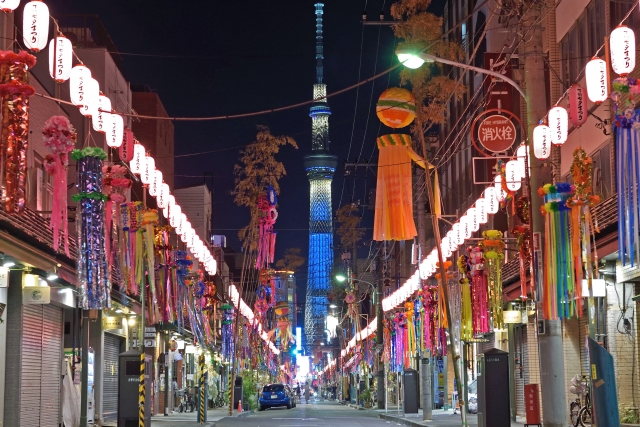
From July to August, the soft afterglow of Tanabata lingers quietly throughout the streets of Tokyo. You may find tanzaku (wish strips) swaying in the evening breeze, or gentle bamboo lanterns glowing faintly in the shadows of skyscrapers. These unexpected sights invite you to pause for a moment, offering a sense of calm amid the city’s constant motion.
Tanabata is a night when wishes are sent to the sky—a special evening that arrives only once a year. During this season in Japan, bamboo decorations appear along streets and at shrines, each adorned with handwritten hopes on colorful slips of paper. It feels as if the entire city of Tokyo transforms into a stage, softly lit by countless prayers.
If you find yourself in Tokyo this summer, we invite you to experience the quiet magic of Tanabata in the air.
Here are three places where you can encounter this unique harmony of summer light and heartfelt wishes—perfect for a reflective pause along your journey.
Asagaya Tanabata Festival
When: Early August (celebrated around the traditional lunar Tanabata)
Where: Asagaya Pearl Center Shopping Street
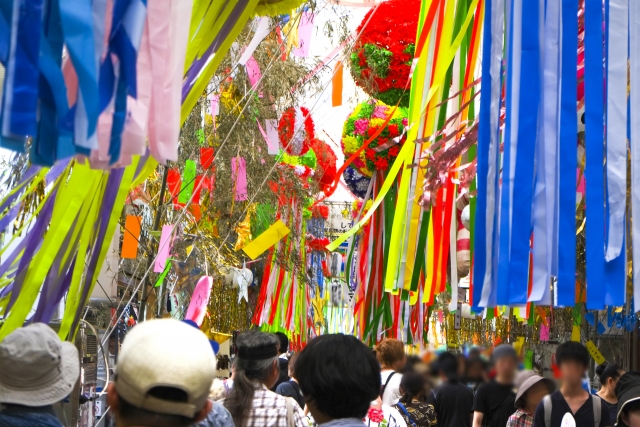
In Asagaya, a neighborhood rich with the charm of Showa-era Japan, the streets come alive every August with vibrant handmade decorations that fill the local shopping arcade. As you stroll through the colorful and nostalgic atmosphere, you’ll be greeted by warm smiles from the local community, evoking the feeling of a classic Japanese summer. It’s a festive yet intimate Tanabata experience, where you can truly feel the heart-to-heart connection between people.
Zojoji Temple Tanabata Festival
When: Early July
Where: Zojoji Temple, Minato Ward

Nestled at the foot of Tokyo Tower, Zojoji Temple hosts a serene Tanabata celebration each July. Bamboo arches adorned with colorful wish strips line the temple grounds, and as evening falls, soft bamboo lanterns illuminate the path with a gentle glow. Despite being so close to one of Tokyo’s major tourist spots, the temple offers a tranquil, almost otherworldly escape. Here, the quiet act of writing and tying a wish becomes a graceful expression of Japan’s understated spirituality.
Tokyo summers are not just about the heat.
Within the sounds, lights, and air of the season, you’ll find a quiet expression of Japanese aesthetics.
And if you wish to experience this sense of elegance through food, there is perhaps no better way than through kaiseki cuisine.
Each dish is like a seasonal poem—crafted with care to let you savor the silence and subtlety of Japanese culture.
Why not spend one evening in Tokyo wrapped in this kind of gentle “light,” through a dining experience that speaks to both the senses and the soul?
Wishes on Paper
When it comes to Tanabata, one of the most iconic customs is writing a wish on a strip of colored paper—tanzaku—and tying it to bamboo. This tradition dates back centuries. In the Heian period, people would grind ink using the morning dew collected on lotus leaves, then write poems or prayers for improved handwriting on the underside of kaji leaves. Writing wishes was originally seen as a way to calm the heart and give shape to one’s intentions—a uniquely Japanese expression of written culture.
The five colors of the tanzaku—blue, red, yellow, white, and black—are rooted in the ancient Chinese philosophy of the Five Elements (Wu Xing), and each color holds symbolic meaning. Blue, for example, represents academic achievement; red, gratitude; yellow, relationships. Choosing a color, selecting words, and expressing one’s hopes in writing—this very act becomes a quiet, reflective moment of prayer for many Japanese people.
At Ise Sueyoshi, a small bamboo branch and tanzaku accompany the hassun course during the Tanabata season. On each tanzaku, a short traditional poem (waka) is inscribed, adding a gentle poetic sentiment to the plate. It is a subtle touch where cuisine and verse, nature and people, softly intersect.
In many ways, writing a wish mirrors the spirit of kaiseki cuisine. The intention behind each dish, the thoughtful consideration for the guest, and the unseen emotions woven into the meal—all reflect the same cultural essence. Whether writing with care or cooking with care, both are quiet expressions of the deep beauty at the heart of Japanese tradition.
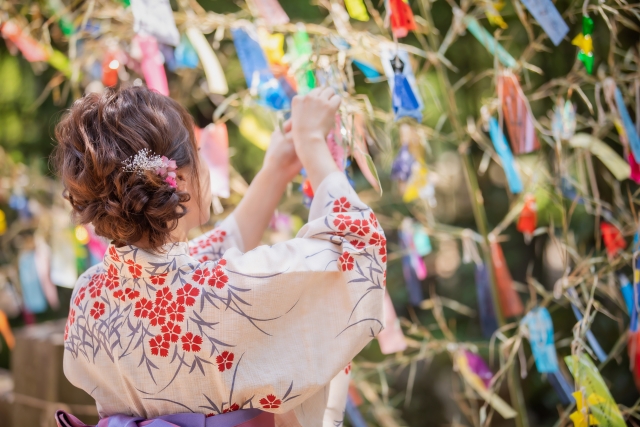
Seasonal Dining Harmony
The essence of kaiseki cuisine lies not simply in taste, but in experiencing the season itself with all five senses. From the ingredients at their seasonal peak to the materials and shapes of the serving ware, the colors and placement of each element, and even the precise timing of each course—every detail is harmonized with the natural rhythms of the season, woven into a single, cohesive “story.”
In July, Ise Sueyoshi’s menu breathes with the quiet spirit of Tanabata, the star festival. For example, the Tanabata Hassun features a small bamboo branch adorned with a tanzaku (wish strip), inscribed with a traditional waka poem. Garnished with bamboo and kaji leaves, the plate becomes a poetic landscape of a serene summer night. Each guest is gifted the tanzaku, allowing them to take home a piece of the season’s memory.
The sashimi course (mukozuke) is served in individually handcrafted fresh green bamboo vessels, creating a visually refreshing presentation. The nimono-wan (lidded soup bowl) bears an elegant bamboo motif on its lid—subtle artistry that tells its own seasonal tale. With each bite, diners are gently reminded of summer’s fleeting presence—on the tongue, in the scent, through texture.
In Japan, summer’s heat is not simply endured but transformed into beauty through the pursuit of “coolness.” In kaiseki, this doesn’t mean merely cold dishes—it is coolness that arrives through visual calm, delicate sounds, and the gentle feel of natural materials.
When the hands of a skilled chef meet the ingredients of the season, the result is a dish imbued with quiet poetry. Each plate becomes a meditation on time and nature—a refined expression of the Japanese aesthetic that finds harmony by living alongside the seasons..
Read more: What is Kaiseki cuisine?
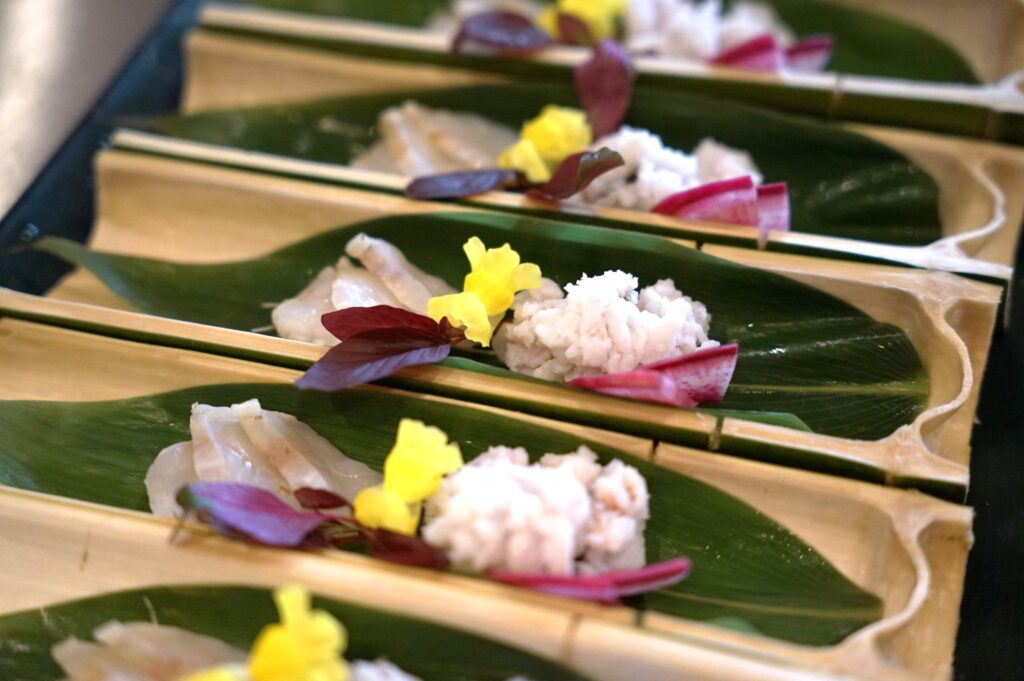
Flavors of Summer
Summer in Japan is a season when the character of each ingredient shines most vividly. As people seek nourishment that is both gentle on the body and rich in flavor during the humid months, seasonal ingredients step into the spotlight and become the true protagonists of the table.
Take hamo (pike conger), for instance—a quintessential summer delicacy in the Kansai region. Preparing hamo requires the expert technique of honegiri, or bone-cutting, where a knife makes rhythmic tapping sounds as it slices through the eel’s countless tiny bones. That distinct ton-ton-ton of the blade is itself considered a sign of summer’s arrival. The flesh, subtle in taste yet profoundly umami-rich, is often served parboiled with plum sauce, capturing a refreshing elegance that only skilled craftsmanship can deliver.
Then there’s kuruma-ebi (Japanese tiger prawn), at its sweetest and most flavorful in summer. At Ise Sueyoshi, it often stars in the nimono-wan (simmered soup dish), its springy texture and oceanic aroma offering a moment of pure seasonal indulgence.
From the rich coastal waters of Ise-Shima, divers known as ama still harvest turban shells (sazae) and abalone (awabi) by hand. These seafood treasures, drawn from a way of life that has endured for centuries, carry with them stories of resilience and harmony with nature. At Ise Sueyoshi, such ingredients are not only honored but also handled with a deep respect for sustainability and cultural heritage.
At the heart of kaiseki lies the philosophy of facing the seasons. Even the same ingredient takes on different aromas, fat content, and hues depending on the time of year. Accordingly, the method of preparation, the choice of dishware, and the presentation evolve in response—this is the essence of kaiseki cuisine.
Dining, then, becomes a once-in-a-lifetime encounter with the season. Each dish is a fleeting reflection of “this very moment.” And through these fleeting flavors of summer, one discovers a deeper connection with nature—a moment in your journey that lingers in memory long after the meal has ended.
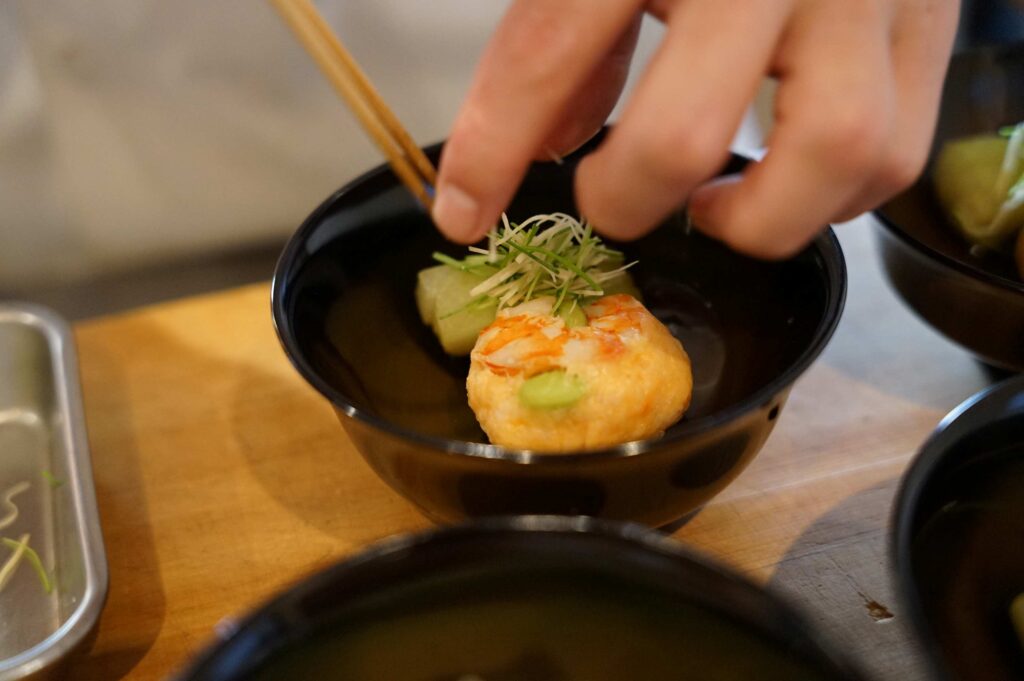
Why Try Kaiseki
On the night of Tanabata, the bamboo leaves sway in the breeze, and paper wishes—tanzaku—gently rise into the evening sky. After experiencing such a poetic and tranquil moment, there is no better way to continue immersing yourself in Japanese culture than by discovering its culinary expression of beauty: kaiseki cuisine.
Kaiseki is far more than a “luxurious multi-course meal.” It is a deeply refined cultural experience that allows you to taste the spirit of Japan through all five senses.
Originating from the light meals once served in the tea ceremony, modern kaiseki has evolved into a pinnacle of Japanese culinary artistry. Every element—from the careful selection of ingredients to the design of the dishware, from the order of presentation to the precise timing of each course—is rooted in the philosophy of ichiju-sansai (one soup, three dishes), embodying a delicate balance of form and essence.
At its core is a pursuit of simplicity and elegance—bringing out the innate flavors of seasonal ingredients while avoiding excess. Like a haiku or a brushstroke in calligraphy, kaiseki speaks through space, pause, and restraint, conveying feeling through subtlety. It is nothing less than a culinary form of fine art.
Just as Tanabata itself is a poetic marker of summer, kaiseki is intrinsically tied to the rhythm of the seasons. During the Tanabata period, one may encounter dishes served in chilled green bamboo vessels, with arrangements reminiscent of stars or swaying bamboo, and dashi broth as delicate and clear as the sound of wind chimes—all evoking the essence of summer through taste, scent, sight, and sound.
What makes a journey truly unforgettable is not just the scenery, but those moments when we connect deeply with the culture of a place. In those moments, our hearts open, and the experience becomes lasting and real. Kaiseki offers just such an entrance—a quiet path into the soul of Japan. Carrying the serene feeling of the Tanabata night, why not take a step into a world where the changing seasons and the heart of Japanese culture reveal themselves, one beautiful dish at a time?
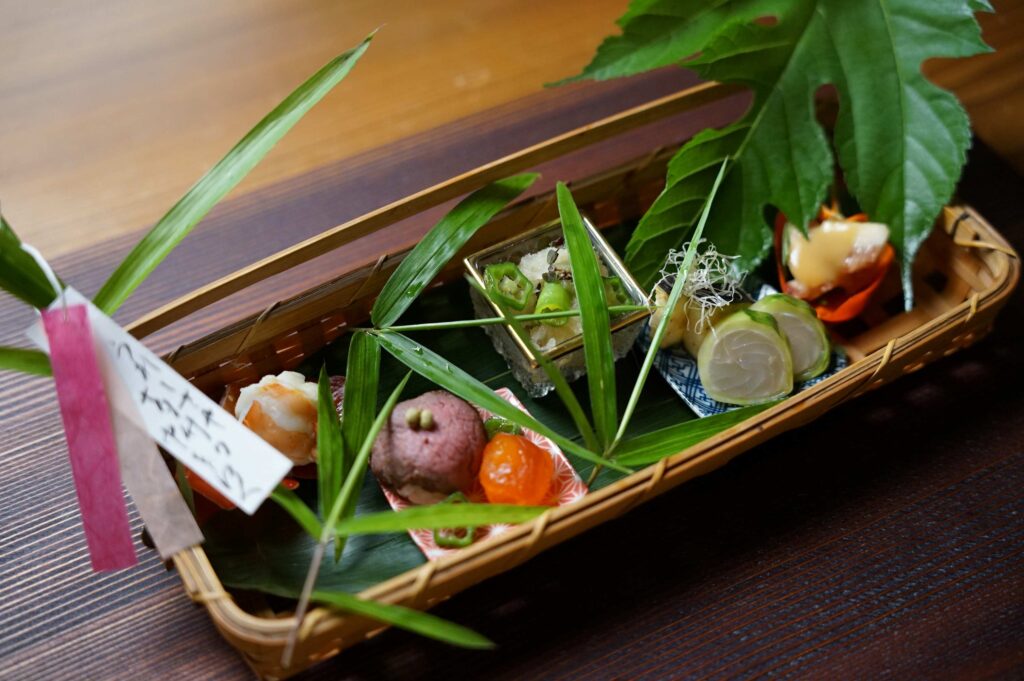
What Is Kaiseki?
The word kaiseki (懐石) originally comes from a practice among Zen monks, who would place warm stones against their bellies to stave off hunger—“stones held close to the heart.” It speaks to a spirit of gentle compassion, of quietly offering comfort to another.
Modern kaiseki cuisine inherits this ethos, evolving into a refined culinary art form. It does not rely on flamboyant presentation. Instead, it engages in a quiet dialogue with nature, with the seasons, and with every detail of hospitality. Kaiseki is an experience that celebrates restraint, elegance, and intention.
Every dish is served in a vessel carefully chosen to suit the season—perhaps a cool green bamboo bowl in summer during Tanabata, or earth-toned pottery reminiscent of autumn leaves in fall. What fills these vessels is the finest seasonal ingredients, selected at their peak and prepared at just the right moment.
Each course is presented in sequence, and with every dish, the story progresses. The aroma of broth as you lift a lacquered lid, the warmth of the bowl in your hands, the texture as you take a bite, the gentle rhythm of interaction with the chef or staff—kaiseki is a quiet art, experienced through all five senses.
Kaiseki is also a temporal art—a fleeting harmony between time and taste. Every dish is prepared and served at the exact moment it is at its most delicious. Even the movements, breaths, and subtle gestures of the chef become part of the performance.
For first-time guests, there is no need to feel intimidated. Kaiseki is not meant to be rigid or formal; rather, it is a form of hospitality that gently accompanies you, inviting you to relax and reflect. In restaurants that thoughtfully explain the cultural background and meaning behind each dish, the experience becomes even richer and more memorable.
Kaiseki is a poetic expression of Japanese nature and spirituality, served one plate at a time. In its quietude lies a lasting resonance—an embodiment of Japanese culture itself.
Read more: What is Kaiseki cuisine?
Tokyo Cultural Dining
Nestled in a quiet alley of Hiroo, Tokyo, Ise Sueyoshi is an intimate kaiseki restaurant with only 10 seats—an elegant hideaway far removed from the city’s bustle. Just a short step away from the urban rhythm, you’ll find yourself immersed in a different world of calm. Dining here feels like entering a poem: quiet, refined, and unforgettable.
Thanks to its small size, Ise Sueyoshi offers a slow, mindful experience. Each course is served with care, attuned to the guest’s pace and expression. The Japanese aesthetic flows through every detail—from the soft lighting to the elegant tableware and the respectful rhythm of service—making the space itself feel like part of the kaiseki experience.
At Ise Sueyoshi, we serve authentic seasonal kaiseki using Japan’s finest ingredients. For example:
- Ise ebi (spiny lobster) from the seas of Mie Prefecture is prized for its tender texture and natural sweetness.
- Awabi (abalone), gently cooked, offers a deep aroma and silky softness.
- Wagyu beef melts in your mouth, leaving a rich umami flavor.
- In addition, guests can savor rare natural fugu (pufferfish), expertly prepared, or indulge in maguro (tuna) dishes that highlight the peak of the season.
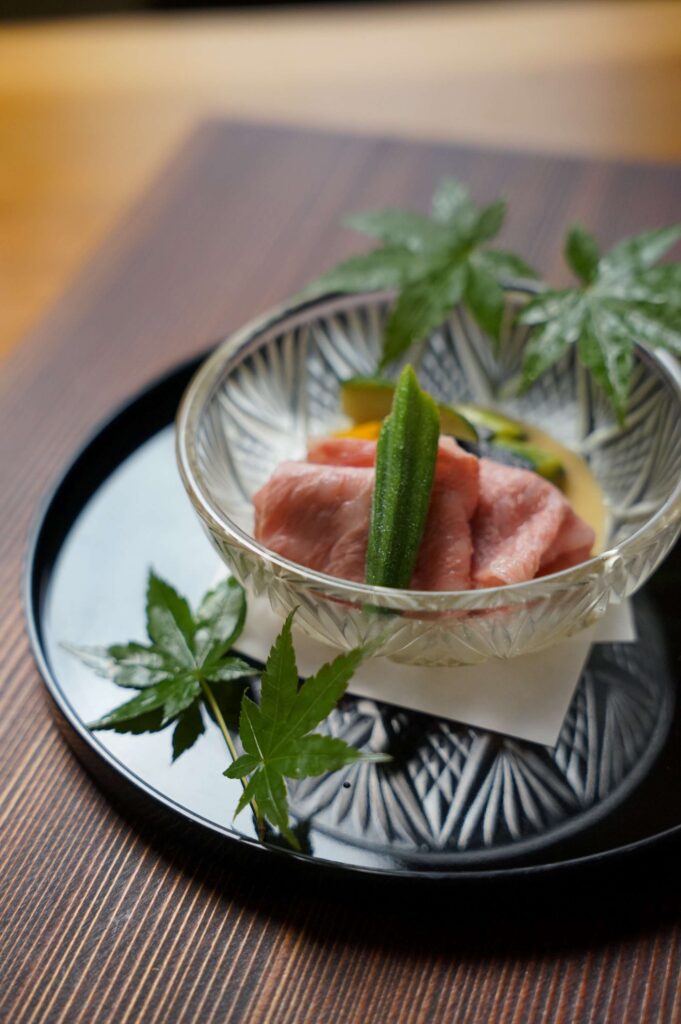
Behind the counter stands Chef Yuuki Tanaka, owner and master of the kitchen. With fluent English and a warm personality, he prepares each dish in front of you while sharing its story, offering a live culinary experience. His presence is especially reassuring for guests who are new to Japanese cuisine and culture.
Here, a meal is not just nourishment—it’s a cultural encounter. From the choice of vessels and the presentation of ingredients to the aroma, texture, and even the silence between courses, everything reflects the refined sensibilities and aesthetics of Japanese culture.
For travelers seeking more than sightseeing—those who wish to experience Japanese culture through food—Ise Sueyoshi is the perfect destination. No formal dress code is required, only an open heart to quietly converse with the spirit of Japan through each thoughtfully crafted dish.
Read More about Wagyubeef
Read More about fugu (pufferfish)
Read More about Ise Ebi Lobster
Read More about Tuna
Heart to Table
At Ise Sueyoshi, the goal is not simply to serve something delicious. Chef Yuuki Tanaka embraces a philosophy that goes one step further—“Kokoro no Ryūtsū”, or the “circulation of the heart.” This concept views cuisine not just as nourishment for the body or a treat for the palate, but as an invisible gift that carries the heartfelt intentions of the chef to the hearts of the guests.
Many of the ingredients and sake used at Ise Sueyoshi are sourced from Chef Tanaka’s home prefecture of Mie. These include shellfish hand-harvested by ama (traditional female divers), wild vegetables grown in the mountain foothills, game meat from the forests, and artisanally brewed local sake. Every item carries with it a story—a trace of the land, the people, and their way of life. Chef Tanaka crafts each dish with a deep understanding of and respect for these backgrounds, transforming them into expressions of gratitude and artistry.
One of the restaurant’s most distinctive touches is the booklet presented with each course, introducing the actual producers behind the ingredients. Learning their names, faces, and stories creates a personal connection—each bite becomes more than a flavor, evoking a sense of closeness and thankfulness. The simple phrase “Itadakimasu” (“I humbly receive”) gains deeper meaning when guests realize the lives, landscapes, and hands behind the food.
And this flow of heart is not one-way. The words and smiles of guests are often shared with the producers through the chef, creating a cycle of encouragement that fuels their passion and leads to even better ingredients in the future. It is this circle—the circulation of heart—that lies at the core of Ise Sueyoshi’s culinary mission.
When dining becomes a memory that lingers long after the trip ends, it’s often because something deeper than taste was shared. A meal that invites you to imagine the people, the place, and the care behind each bite becomes a truly personal experience—one that delivers heart as well as flavor, and transforms your journey into something unforgettable.
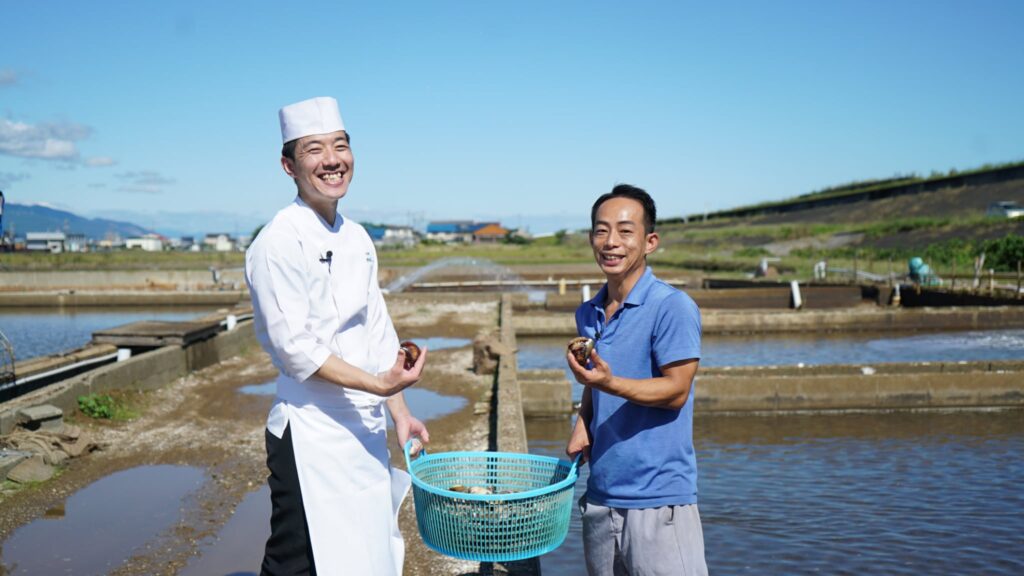
Read More about Chef Yuuki
The Story of Tokyo’s Best Chef, Yuuki Tanaka: Bringing the Blessings of His Hometown to the World
Graceful Hospitality
The experience of kaiseki is not complete with food alone. The sound of porcelain, the subtle aroma of the space, and above all, the human presence—it is the harmony of all these elements that transforms a meal into a true cultural encounter. At Ise Sueyoshi, as much care is placed on how you are welcomed as on what you are served. Hospitality here is an extension of the cuisine itself.
In Japanese culture, graceful service means anticipating a guest’s needs by “half a step.” Not intrusive, but never delayed. Attentiveness is expressed through subtle actions—approaching quietly before being called, reading the mood rather than interrupting it. This delicate balance creates an atmosphere that is both peaceful and reassuring.
At Ise Sueyoshi, great effort is made to explain the background of each dish, its ingredients, and even the intentions behind the chosen tableware—all in fluent English. This ensures that guests, even on their first trip to Japan, never leave wondering what they just experienced. In many restaurants across Japan, explanations are kept to a minimum, which can leave international visitors yearning for deeper cultural insight.
But Ise Sueyoshi is different. With just ten seats, the space allows for genuine one-on-one interaction. It’s an intimate, unhurried setting where guests can comfortably immerse themselves in the culture—a space that offers more than a meal; it offers a moment of trust and reflection.
What stays with you isn’t just the taste of the dishes. It’s the quiet words, the thoughtful gestures, the attentive gaze. It is the heart conveyed through people that gently wraps the entire evening in warmth—making the experience unforgettable.
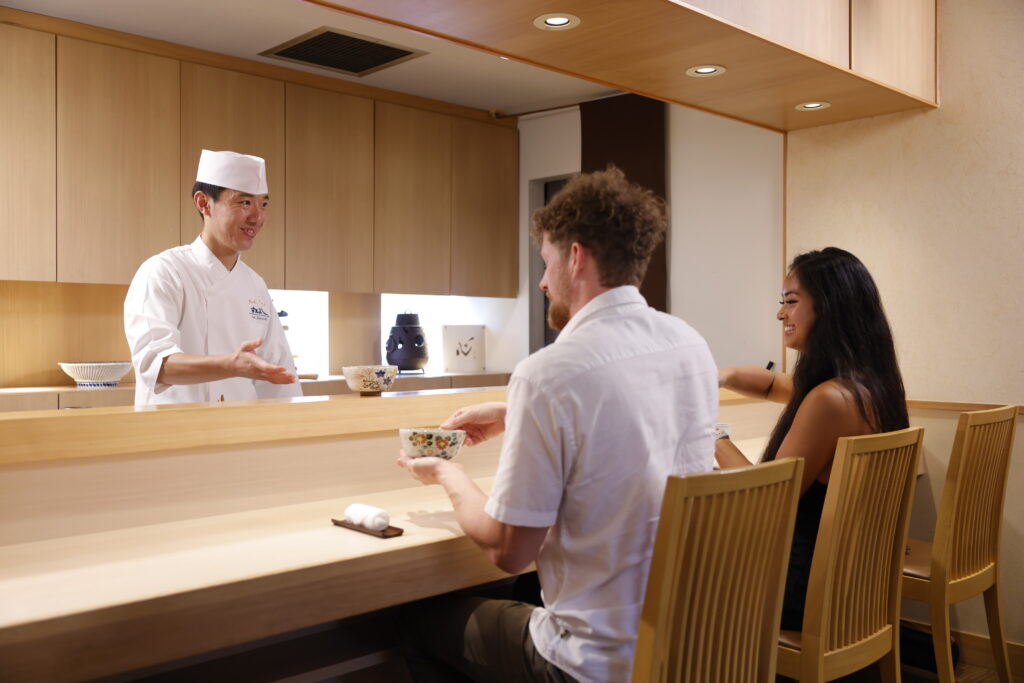
Inclusive Fine Dining
At Ise Sueyoshi, the culinary philosophy is rooted in the idea that no one should ever feel left out. This compassionate perspective stems from the life experience of Chef Yuuki Tanaka. In his younger years, he traveled to over 15 countries, learning in kitchens around the world. Along the way, he engaged with diverse cultures, religions, and dietary values—and came to realize two important truths: first, that even the word kaiseki is largely unknown outside Japan, and second, that food transcends borders and beliefs—it connects hearts.
This global perspective informs the restaurant’s remarkably flexible approach to fine dining. Ise Sueyoshi has welcomed guests with a wide range of dietary needs: vegetarian, vegan, gluten-free, shellfish allergies, dairy-free, and more. What makes the response special is not just offering substitutions, but doing so with deep respect for each guest’s background—while preserving the delicate refinement that defines kaiseki.
Because all dining is by reservation only, the team takes time in advance to listen carefully to each guest’s preferences and needs. Every dish served becomes a silent message of welcome—crafted specifically for the person enjoying it.
Perhaps the true meaning of fine dining lies not in price or prestige, but in an attitude of care. Ise Sueyoshi is a place where no one needs to feel intimidated, and where kaiseki can be experienced on your terms—aligned with your values, your body, and your beliefs.
Sharing the beauty of kaiseki with the world—that is the spirit infused in every plate at Ise Sueyoshi.
For more about our vegan or vegetarian please visit this page.
For more about our gluten-free please visit this page.
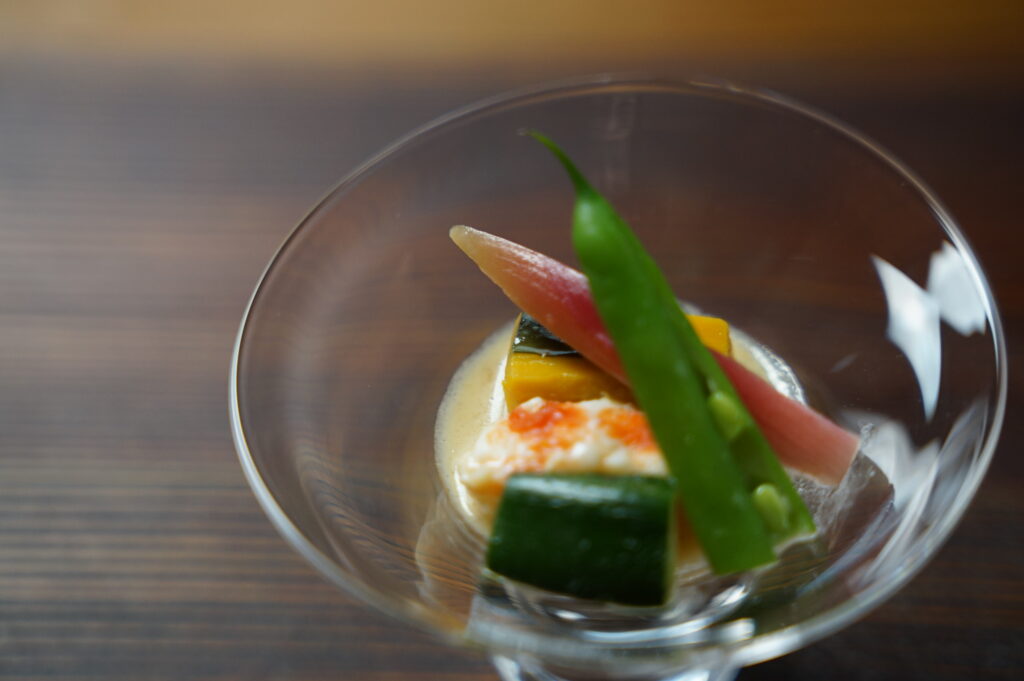
Artful Beverage Match
The delicate world woven into each course of kaiseki cuisine gains even greater depth when paired thoughtfully with the right beverage. At Ise Sueyoshi, drink pairing is not an afterthought—it is an essential part of the culinary design, with a strong focus on harmony between food and drink, especially with Japanese sake.
All sake served here is carefully selected from Mie Prefecture, the hometown of Chef Yuuki Tanaka. Each variety is chosen to complement the season’s ingredients—not only in terms of flavor, but also aroma, temperature, and finish. The pairing process is led by the proprietress, who holds a certified sommelier license, and developed in collaboration with the culinary team through multiple rounds of tasting and dialogue. Behind every perfect match is a quiet passion and deep respect for detail.
What sets Ise Sueyoshi apart is its belief that the sake vessel itself is part of the pairing. The texture of the rim, the feel in the hand, and the temperature retention—all are chosen to enhance the experience of both the drink and the dish it accompanies.
Here, beverages are not just an accessory—they are the final piece that completes a lasting memory. Many guests leave remembering not just the flavors, but the pairings that linger in their hearts: “I’ll never forget that dish with that sake.”
In Japan, taste and memory are deeply entwined. The beverage experience at Ise Sueyoshi is crafted to quietly and beautifully enrich the afterglow of your journey, long after the meal has ended.
Read more about Sake Pairing:
Enhance Your Kaiseki Experience in Tokyo: Sake Pairing for Ultimate Satisfaction
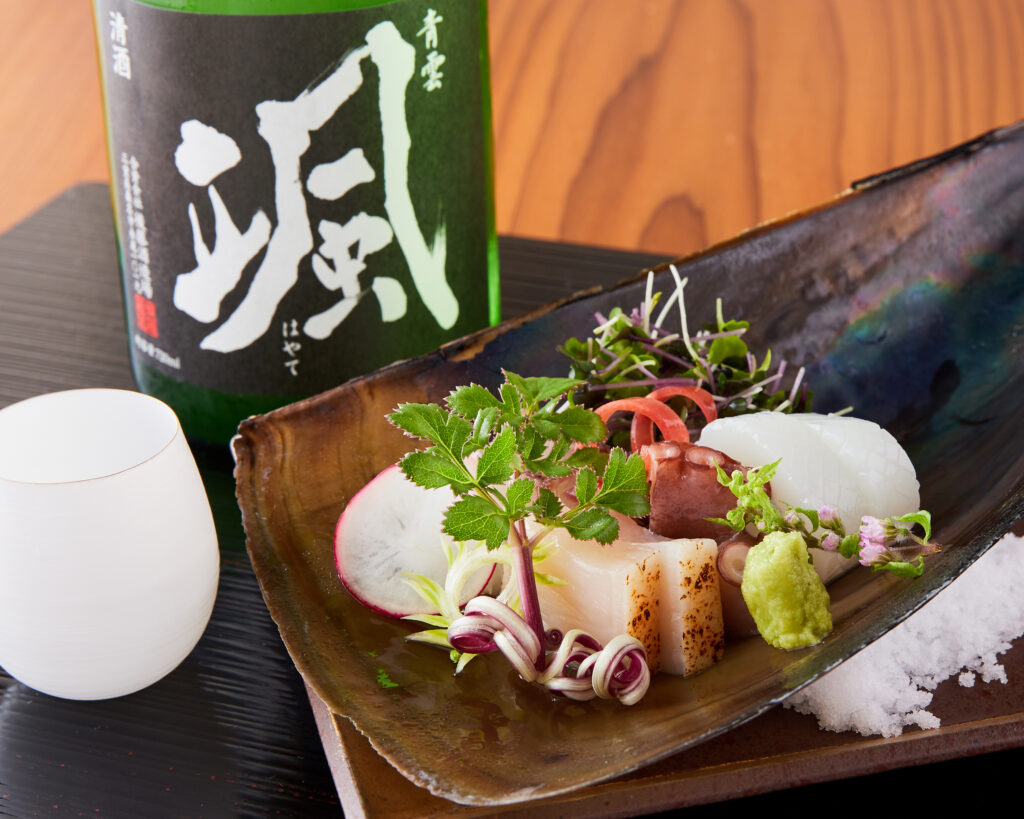
Perfect Trip Finale
Many guests choose to dine at Ise Sueyoshi on the final night of their journey. Whether it’s a birthday, honeymoon, or a celebration of life’s milestones, this small, hidden gem is often entrusted with some of the most important moments of a trip. Beyond exquisite flavors and beautiful presentation, what truly sets Ise Sueyoshi apart is the sense of stillness and lingering calm that gently wraps around each guest—an atmosphere perfectly suited to conclude a meaningful journey.
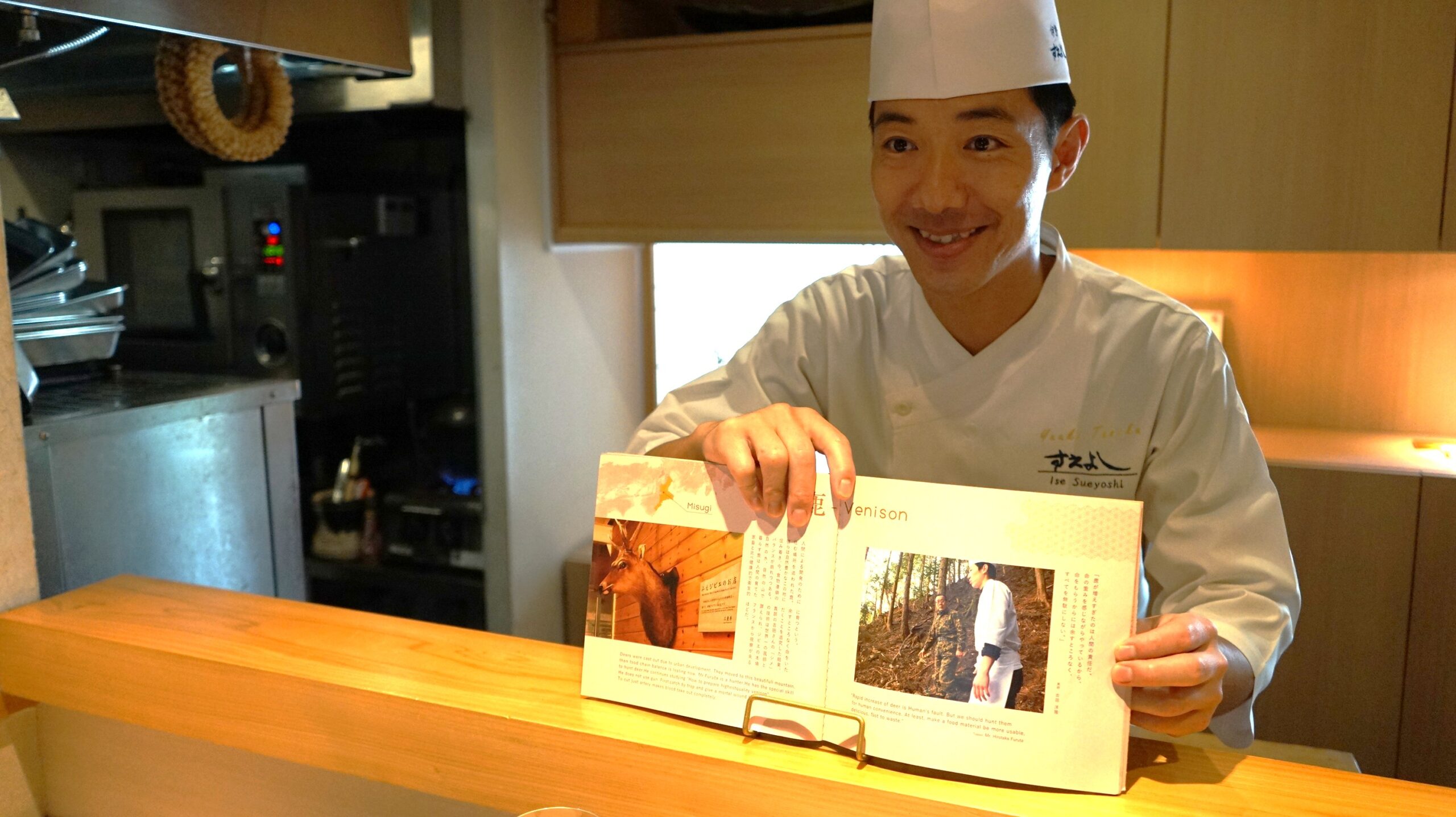
The unhurried rhythm of the meal, the gentle, unobtrusive conversation, and the graceful gestures of placing each dish—all come together to ease away the tension of daily life. It is a delicate dance between emotional uplift and quiet reflection, allowing memories of the trip to slowly settle and take shape.
Location also plays a key role. Nestled in a quiet street near Hiroo and Roppongi, the restaurant is easily accessible by taxi from major areas, making it a convenient yet peaceful escape from the city’s bustling energy. A short distance from Tokyo’s more vibrant districts, Ise Sueyoshi offers a space of elegance and tranquility, where you can retreat and exhale.
This is a place where, on your final night, you may find yourself thinking, “Japan truly is beautiful.” We hope you’ll share that serene moment with someone dear to you. In fact, many of our guests book their dinner here as a gift experience, a way to express appreciation, love, or celebration. To be chosen for such moments is an honor we hold deeply.
Many choose Ise Sueyoshi as a gift dinner for birthdays or honeymoons.
Learn more this article.
Our Guest’s Voice
An impeccable Kaiseki Experience
Jun 2023
What an impeccable #kaiseki experience – both culinary and culturally. We were only 4 people in the restaurant and Chef Yuuki Tanaka prepares everything from the seasonal ingredients from his hometown Ise. Our evenings theme was inspired from the “rain season” in Japan. We enjoy every bits of the food but the stand outs of the night are Fugu “puffer fish” and Ise Maguro sashimi, Matcha coated lobster, wagyu, milky clamps and matcha “soufflé” . If you are looking for special night out you won’t regret a second. Highly recommended !
We are proud to continue delivering an exceptional dining experience that earned us the Tripadvisor Travelers’ Choice Best of the Best 2024 award, ranking among the Best Restaurants in Tokyo. Our commitment to excellence in service and our dedication to offering the finest kaiseki dining experience in Tokyo remain unwavering. Discover more about our journey to becoming one of the best restaurants in the city[here].

Visit Ise Sueyoshi
Location: Conveniently located 12 minutes from Roppongi Station and 8 minutes from Hiroo Station.
Hours: Open 5:00 PM – 10:00 PM, reservations only. Closed on Sundays and Mondays.
Book Your Experience ☟
Reservation Information
In response to many requests from our guests, Ise Sueyoshi now accepts reservations up to 180 days in advance of your preferred dining date.
With only 10 seats available, we are committed to providing a smooth and personalized reservation experience.
To ensure you don’t miss the opportunity to celebrate your important anniversaries or special occasions with us, we highly recommend making your reservation as soon as your plans are set.
If you are planning a trip to Japan, we warmly invite you to include a special moment at Ise Sueyoshi in your itinerary.
Many of our guests also choose us for their final evening in Japan, as a beautiful and memorable way to conclude their journey.
Please note that our reservation policies may change without prior notice. For the latest updates, please refer to our reservation page.
Conclusion
At Ise Sueyoshi, we humbly invite you to experience a dining journey that caters to all dietary needs. Whether you’re vegan, halal, or have specific preferences, we are here to create a memorable and inclusive dining experience for you, especially for special occasions like a honeymoon.
Recommended Blog Posts
On our blog, we offer further insights into Tokyo’s rich food culture and the unique culinary experiences we provide at Ise Sueyoshi. Be sure to check out these recommended posts:
Where Fireworks Meet Tokyo Kaiseki: A Summer Night of Elegance |
Why You Must Try Kaiseki Cuisine in Tokyo: A Unique Experience of Culinary Art and Intellectual Delight |
@isesueyoshi
o 🏆 Awarded the prestigious Best Luxury Restaurant by TripAdvisor
o 🌍 Ranked 2nd worldwide, 1st in Japan, and 1st in Asia
o ⭐ Google rating of 4.9 (as of 2024)
o ✅ Vegan-friendly
o ✅ Halal selections
o ✅ Gluten-free options
o ✅ Vegetarian delights
o ✅ Pork-free choices
o ✅ Perfect for pescatarians
o 🌈 Welcoming and inclusive environment for LGBTQ guests
o 🚃 Just a 12-minute walk from Roppongi Station or 8-minutes from Hiroo Station
o ⏰ 5:00 PM – 10:00 PM (reservations-only)
o 📅 Closed on Sun and Mon
